Caregiver Resource Guide: Organize Care and Support with Ease
What is a caregiver resource?
A caregiver resource is a collection of essential tools, templates, and information designed to help family caregivers organize, manage, and track all aspects of care for their loved ones. Whether you’re caring for a neurodivergent child/teen/young adult, a disabled family member, or someone with complex medical needs, a comprehensive caregiver resource system ensures that everything from daily routines to emergency protocols is accessible and up-to-date.
A well-organized caregiver resource can be as simple as a digital dashboard or a physical binder containing medical records, contact lists, routines, etc. Its goal is to make caregiving more accessible, manageable, and efficient, especially during stressful situations or emergencies.
Why a caregiver resource is important for your family
Managing the day-to-day needs of a loved one often involves juggling a multitude of responsibilities. A caregiver resource system helps streamline this process by organizing the most critical information and tasks in one place. Here’s why every family needs a well-organized caregiver resource:
- Centralized information. Keep important documents like medical records, emergency contacts, and care routines in one easy-to-access location.
- Emergency preparedness. In an emergency, anyone stepping in to help can easily follow the caregiving plan without confusion or delays.
- Reduces stress. A clear system reduces anxiety for family caregivers, who know they can quickly find what they need when needed.
- Promotes continuity of care. Ensures consistent care is provided, even if a new caregiver temporarily steps in, avoiding disruptions.
- Saves time. No more searching for information or recalling important details; everything is readily available and well-organized.
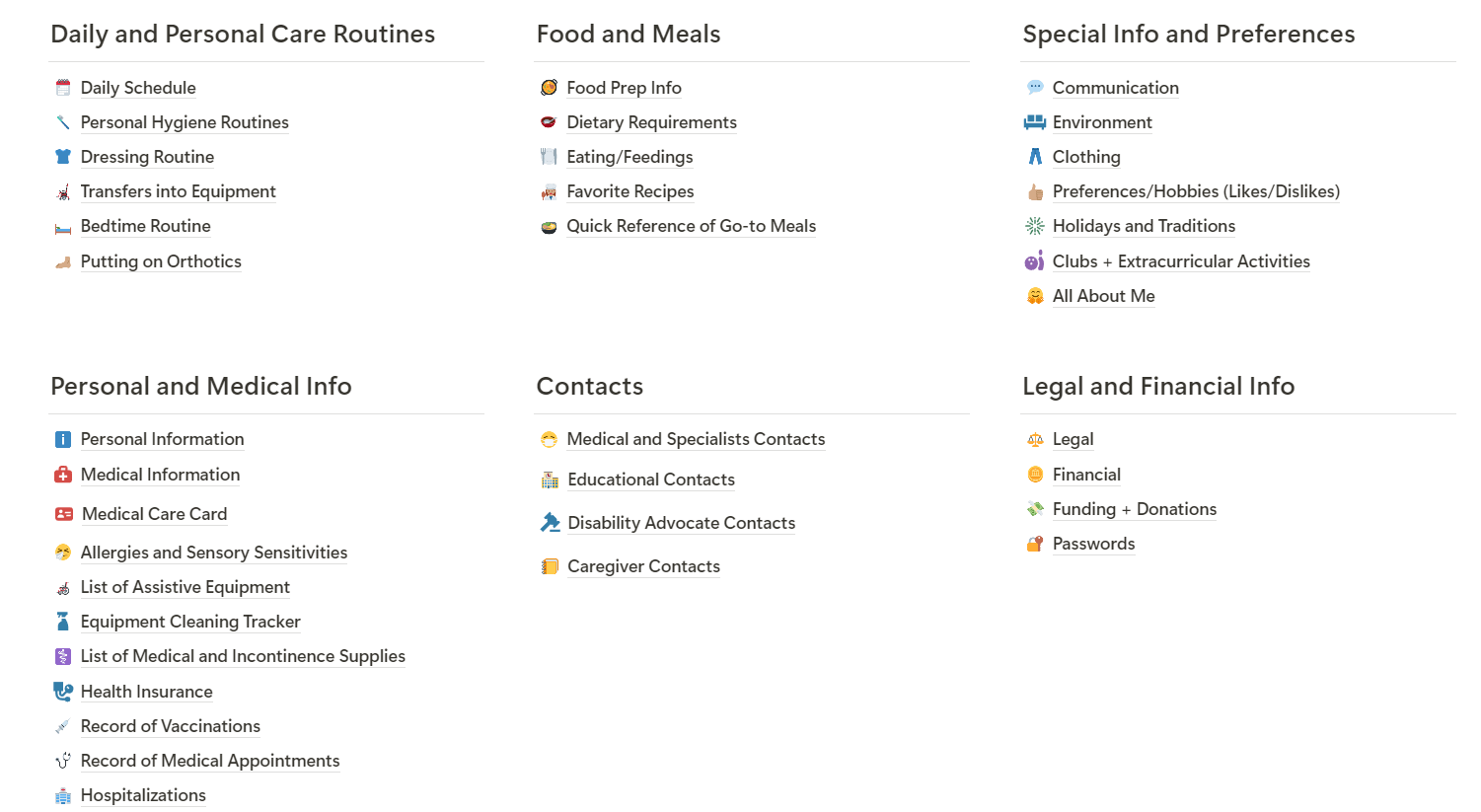
Screenshot of the Caregiver Resource page using Notion as offered through the Caregiver’s Resource Planning Group
How a caregiver resource can simplify daily life
A well-designed caregiver resource can make day-to-day caregiving tasks more manageable and less overwhelming. Here are some ways it can simplify your daily life:
- Routine management
- Quick access to medical information
- Tracking progress
- Communication and handovers with other family members or caregivers is made easy
- On-the-go access (if digital)
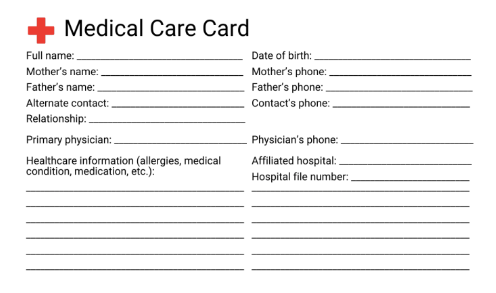
Screenshot of Medical Care Card template as part of the Caregiver’s Resource Planning Group
The benefits of having organized caregiver records
Keeping your caregiver records organized offers numerous benefits for you, your loved one, and any other caregivers involved in their care. Here are some of the key advantages:
- Improves communication. With all information clearly laid out, communication between caregivers, family members, and healthcare professionals becomes smoother.
- Ensures continuity of care. Organized records mean that care can remain consistent, even during transitions between caregivers or healthcare providers.
- Increases efficiency. Keeping everything in a structured format can save time on administrative tasks, allowing you to focus more on caregiving.
- Facilitates decision-making. Organizing all medical histories, routines, and emergency plans helps you make informed decisions about your loved one’s care.
- Supports legal and medical requirements. Easily keep track of appointments, legal documents, insurance information, and medical records, ensuring nothing gets lost in the shuffle.
- Reduces caregiver burnout. A system that simplifies and organizes caregiving tasks can reduce the mental load and stress, helping to prevent burnout.
Research* shows that tasks like organizing, tidying, and cleaning help enhance mood, improve focus, improve productivity, and reduce anxiety and depression.
How to build a comprehensive caregiver resource
Creating a comprehensive caregiver resource doesn’t have to be overwhelming. The key is to break it down into manageable steps and include everything that could be helpful for your caregiving journey. Here’s a simple approach to building your caregiver resource:
- Identify what you need. Start by listing the areas of caregiving that require documentation—daily routines, medical information, contact lists, emergency protocols, and more. Think about what you reference regularly and what others might need to know if they step in to help.
- Choose a format. Decide whether you want to use a digital tool, like Notion, or a physical binder. Digital tools offer flexibility and on-the-go access, but some caregivers prefer to print and store everything in a physical format.
- Gather information. Collect all necessary documents and information, including medical records, therapy plans, legal documents, emergency contact information, and daily care routines.
- Organize by category. Once you have the information, organize it into clear categories. For example, you might have medical, emergency, daily routines, personal care, and contacts sections.
- Keep it up-to-date. Make a habit of regularly updating your caregiver resource. Care plans, medications, and contact details can change frequently; your system should reflect these updates.
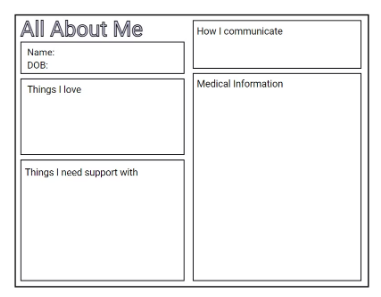
All About Me template as part of the Caregiver Resource Planning Group
Templates for your caregiver resource
To help streamline the organization process, there are several templates you can use to build your caregiver resource. Here are some that may be particularly helpful:
- Daily routine template
- Medical information record
- Emergency contact list
- Emergency protocol template
- Personal care template
- Food and nutrition tracker
- Legal and financial template
Tools for your caregiver resource
Whether you prefer to keep everything digital or prefer more traditional methods, various tools are available to help you build and maintain an organized caregiver resource. Here are some practical tools, both digital and non-digital, that can simplify your caregiving process:
Digital tools
- Notion – A versatile tool offering customizable templates for organizing everything from daily routines to medical records. It’s perfect for family caregivers who need a flexible, all-in-one platform.
- Google Drive – A widely used, free, cloud-based system for storing, sharing, and collaborating on documents and spreadsheets. You can use Google Docs and Sheets to create and manage caregiving records and keep them accessible from any device.
- Trello – A project management tool that helps you create boards for different caregiving categories, such as medical appointments, daily routines, and tasks. It’s a visual way to manage your caregiving responsibilities and keep track of progress.
- Dropbox – Another cloud-based storage tool, Dropbox is great for keeping digital copies of medical records, care plans, and important documents accessible across devices. You can also share files with healthcare providers or family members.
- Microsoft OneNote – A note-taking app that allows you to create digital notebooks for organizing caregiving information. You can categorize notes by different aspects of caregiving (e.g., medical info, personal care) and access them across all your devices.
Non-digital tools
- Caregiving binder – A physical binder with clearly labeled sections for daily routines, medical records, emergency contacts, and other important information. This method is excellent for caregivers who prefer paper over digital formats or want a backup system.
- Printed templates – Create templates for daily routines, emergency protocols, and medical information. These can be filled out by hand and stored in a binder or folder for easy access.
- Index cards – Use index cards to create quick-reference guides for emergency protocols or medications. Color-code the cards for different categories (e.g., medications, contacts, daily care) and keep them in a small box or binder.
- Whiteboard/planner – A wall-mounted whiteboard or planner can help you manage day-to-day caregiving tasks and appointments. It allows for quick updates and is especially useful for families with multiple people involved in caregiving.
- Accordion file folder – Organize legal documents, insurance papers, and other important caregiving information in an accordion file folder. It’s a simple, non-digital solution for keeping everything organized and easy to find.
- Sticky notes – Use sticky notes to jot down quick reminders or updates. To keep everyone on the same page, these can be added to a caregiving binder or placed in prominent locations around the home.
- Calendar (paper) – A physical calendar where you can record appointments, therapy sessions, medication schedules, and daily routines. A paper calendar can provide a clear visual overview of upcoming caregiving responsibilities.
Benefits of using a digital platform for your caregiver resource
Managing caregiving records can be made significantly easier with a digital platform. Whether you choose Notion, Google Drive, or another tool, a digital platform offers flexibility, accessibility, and convenience for organizing all aspects of caregiving. Here’s how a digital platform can help streamline your caregiving resource:
- Customizable templates
- Centralized access
- Collaboration and sharing
- Reminders and task management
- On-the-go flexibility
- Printability for physical use
Building and maintaining your caregiver resource (with community accountability)
Creating a caregiver resource is a vital first step, but keeping it up-to-date is just as important. As your child’s needs change or new information arises, reviewing and maintaining your caregiving system regularly is essential. However, with so many daily responsibilities, staying organized can feel overwhelming. That’s where the power of community accountability comes into play.
If you want to ensure that your caregiving resource is built and stays current, supported, and practical, the Caregiver’s Resource Planning Group can help. This group is designed to provide caregivers with the tools, structure, and community support they need to stay on top of their caregiving records—no matter how busy life gets.
How the Caregiver’s Resource Planning Group can help
- Stay accountable
- Learn from others
- Step-by-step guidance
- Community support
- Access to a Notion dashboard with 50+ caregiving records
Join the Caregiver’s Resource Planning Group, where our goal is to organize our caregiving records so that we (or anyone else) can easily understand and use them.
If you’ve ever wanted to organize things for your child beyond education, this is how to do it with accountability and community.
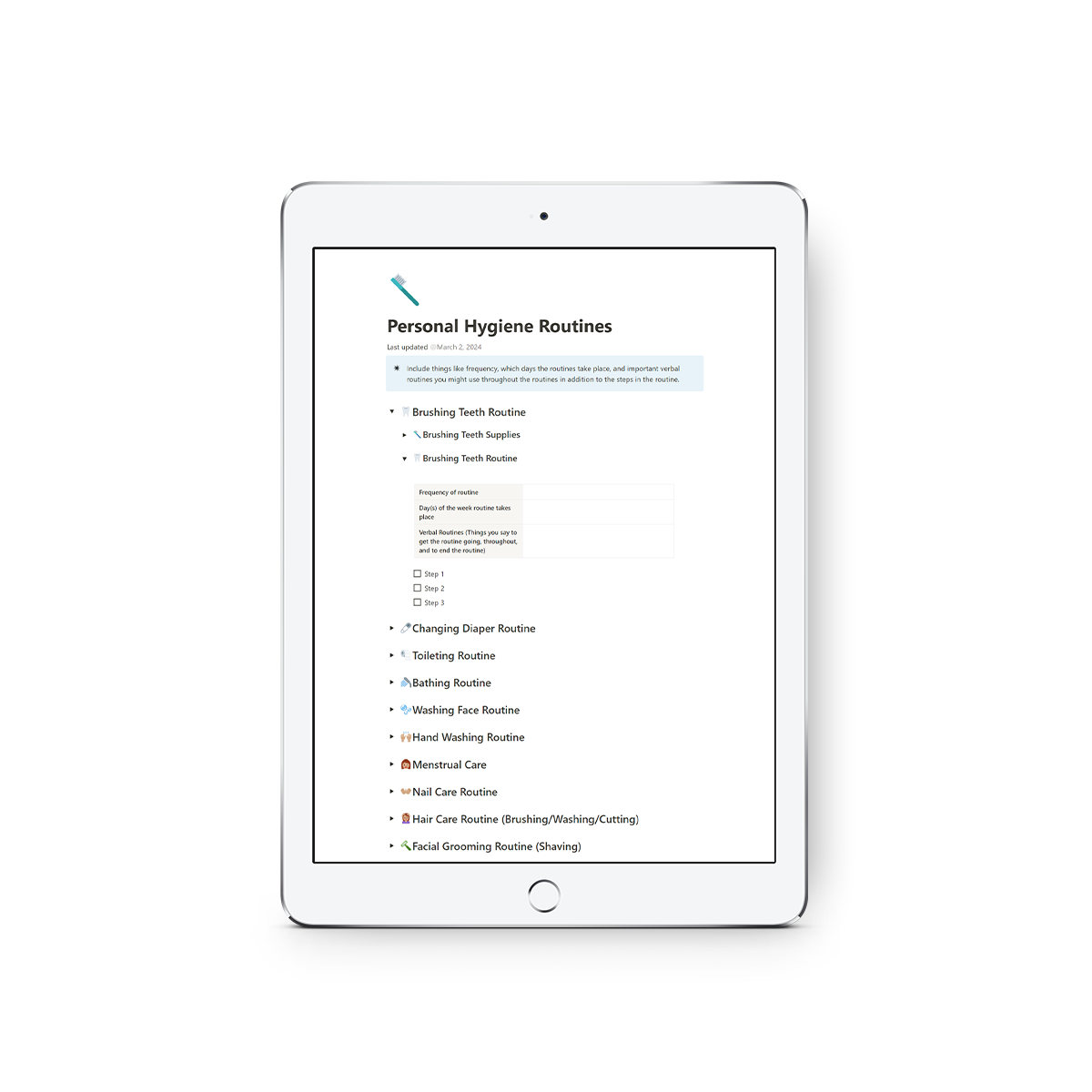
Mockup of a Personal Hygiene Routines page from the Notion template of the Caregiver Resource Planning Group
Sessions
This series consists of six interactive sessions, each designed to help you organize a different aspect of caregiving.
- Session 1: Welcome and Daily Routine Set-up
- Session 2: Personal Care Routines
- Session 3: Personal and Medical Info
- Session 4: Contacts List and Special Information
- Session 5: Emergency Protocol
- Session 6: Meals and Wrap-up Session
Each session is an opportunity to organize, learn, share, and connect with other caregivers in our community.
By joining the Caregiver’s Resource Planning Group, you’ll stay organized and build a support system of caregivers who understand your journey. Together, we can maintain and improve your caregiving resources, ensuring they’re always ready when you need them most.
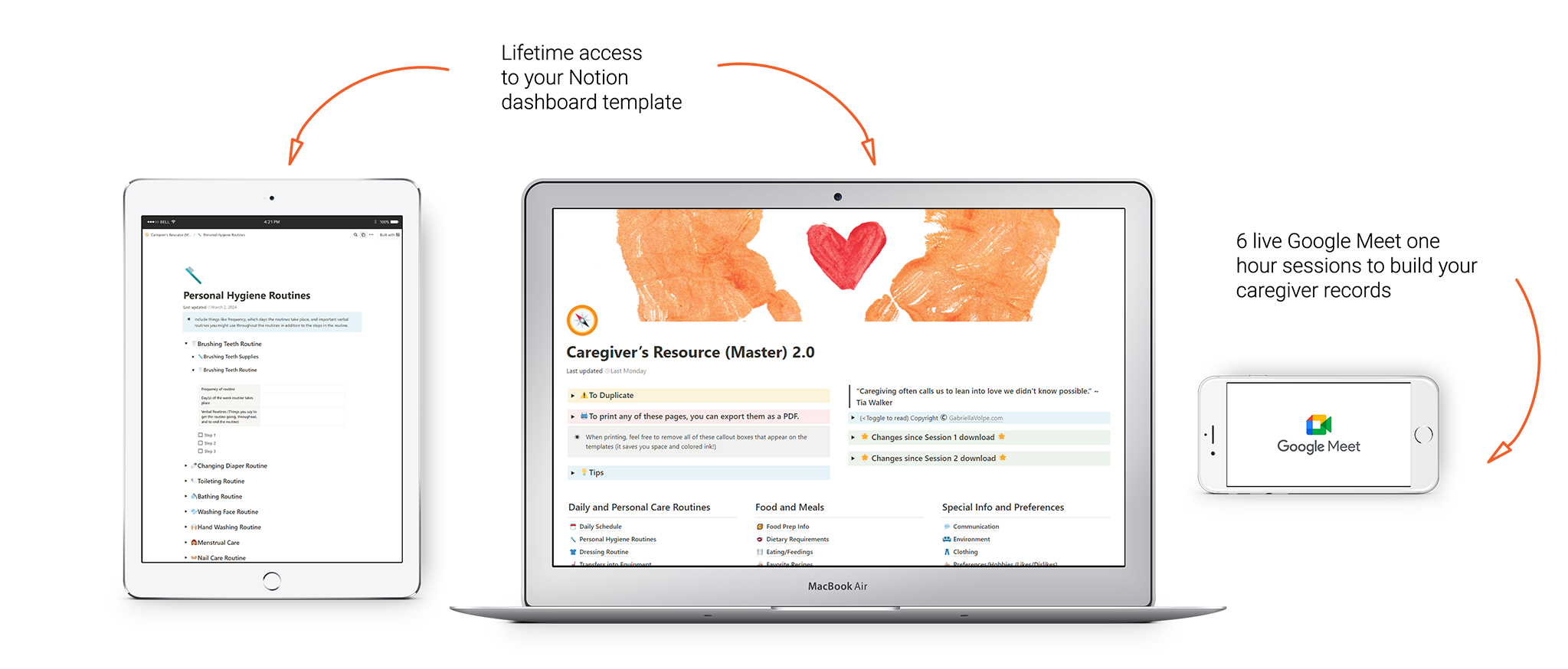
Mockup of Caregiver Resource Planning Group template
Registration
Upon registration, you’ll receive links to Google Meet. At our first meeting, you will have access to the Notion dashboard (with all the resources).
Register or sign up here to be notified when the next sessions begin!
FAQ
“I want to join but am hesitant about participating in discussions. What will our sessions look like?”
Each session will roughly follow this format:
- Discussion around the topic/task(s) we’re tackling
- Sharing (optional/voluntary)
- Homework component (so that you can run with the momentum and finish the task(s)!)
The approach is one of a trauma-informed perspective. You are not obligated to do anything that makes you feel uncomfortable. You can participate as much or as little in this space as you’d like.
“What if I can’t make the group sessions? Will there be a recording?”
Because our children’s caregiver experiences are vulnerable, I won’t be recording the sessions. However, after each session, I will summarize the most important things you missed, tips and tricks, and homework.
“What if I want the resource without the group sessions? I work during those hours and know I can’t be there.”
This product is attached to the group sessions. The group’s purpose is to help us build community and remove us from our isolation as family caregivers while being proactive in our roles (as opposed to group therapy sessions—no dig at group therapy, just saying this is different).
This is your opportunity to meet other parents with similar experiences while working toward similar goals, like getting paperwork in order. (Bonus: Once you get started, you will likely find the motivation to get other things in your life in order!)
“I am home with my kid(s), and I worry they may interrupt.”
No problem. My kiddo will also be around in the background. You are free to come and go as your child needs! That’s what’s great about mute and camera toggles!
“I am not keen on a digital platform. I prefer to write things down.”
The caregiver’s resource is a system. It’s a suggestion—a model, a tool. Inspiration. You can take what you’d like from it and recreate the version you prefer for your family.
However, I bet you will LOVE the (Free) Notion platform because it’s so versatile. You can enter information on your computer or tablet, and then you can have everything in your hand on your phone. This allows for easy access when you are on the go, at appointments, or even in bed at night when that thought comes to you at 3 am!
All templates can be printed and added to a binder (or other system you design). You can print the templates blank and handwrite or type all the data and print it ready. If you keep a digital copy, it’s straightforward to update as therapists change, etc. It prevents reinventing the wheel each time there’s a change in your child’s life!
Register or sign up here to be notified when the next sessions begin!
Related articles
Resources
- Informal and Family Caregiver (info for residents of Quebec)
- Canadian Center for Caregiving Excellence
- U.S. Department of Health and Human Services – Resources for Caregivers
- Embracing Carers – Resources for Caregivers Around the World
* References
Lee, S. W. S., Millet, K., Grinstein, A., Pauwels, K. H., Johnston, P. R., Volkov, A. E., & van der Wal, A. J. (2023). Actual Cleaning and Simulated Cleaning Attenuate Psychological and Physiological Effects of Stressful Events. Social Psychological and Personality Science, 14(4), 381-394. https://doi.org/10.1177/19485506221099428
Schuenemann L, Scherenberg V, von Salisch M and Eckert M (2022) “I’ll Worry About It Tomorrow” – Fostering Emotion Regulation Skills to Overcome Procrastination. Front. Psychol. 13:780675. doi: 10.3389/fpsyg.2022.780675
Are you a family caregiver?
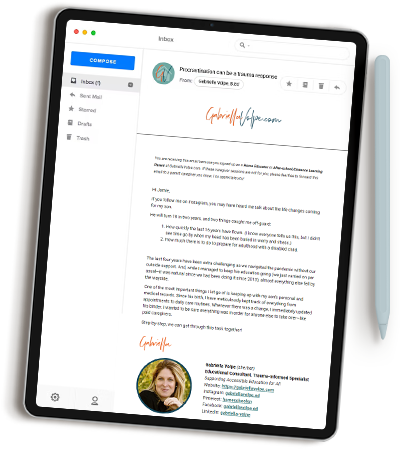
Get more anecdotes and ideas like this one. Sign up to my newsletter for family caregivers:
By signing up for email alerts, you agree to receive updates and promotions to support you as a family caregiver. You can unsubscribe at any time.

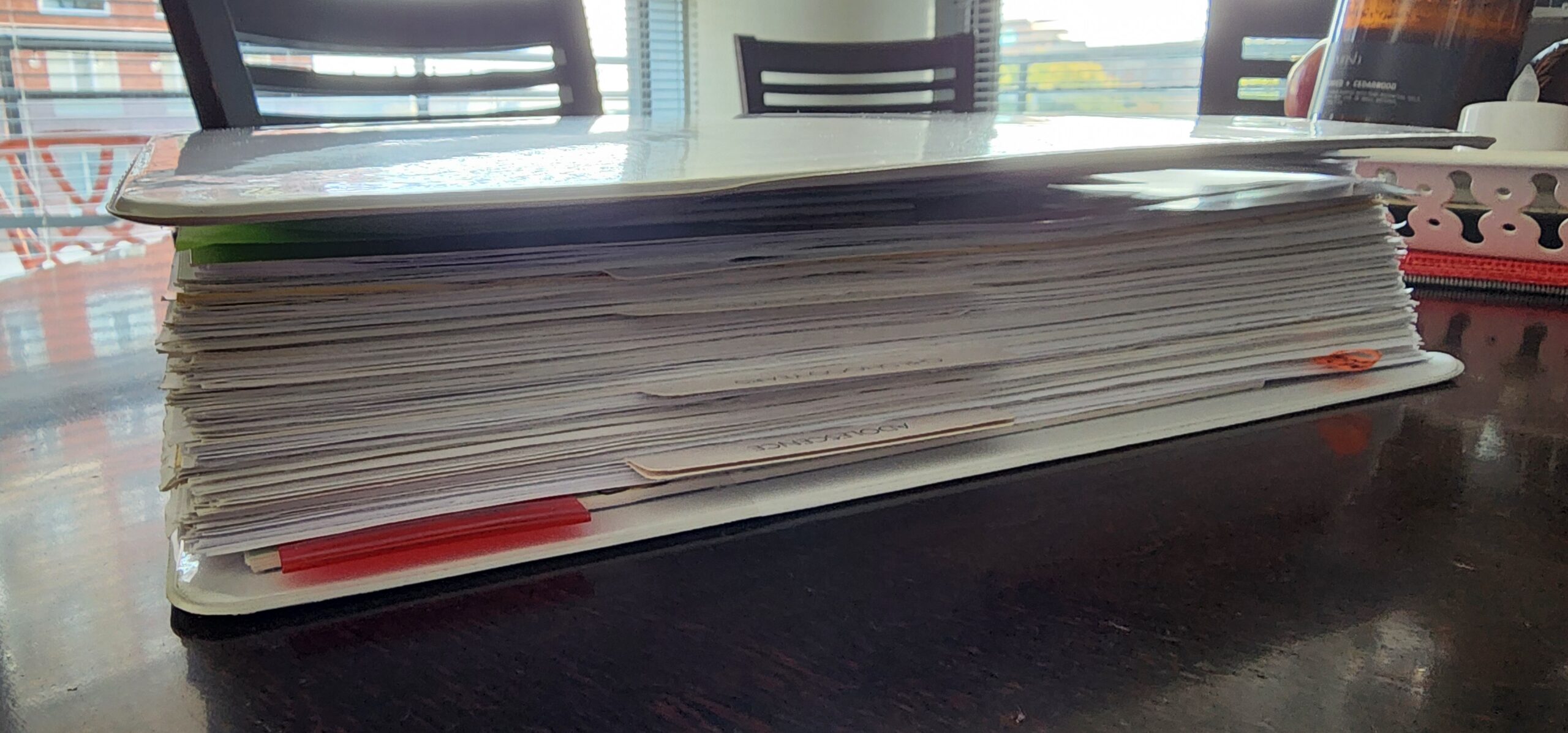
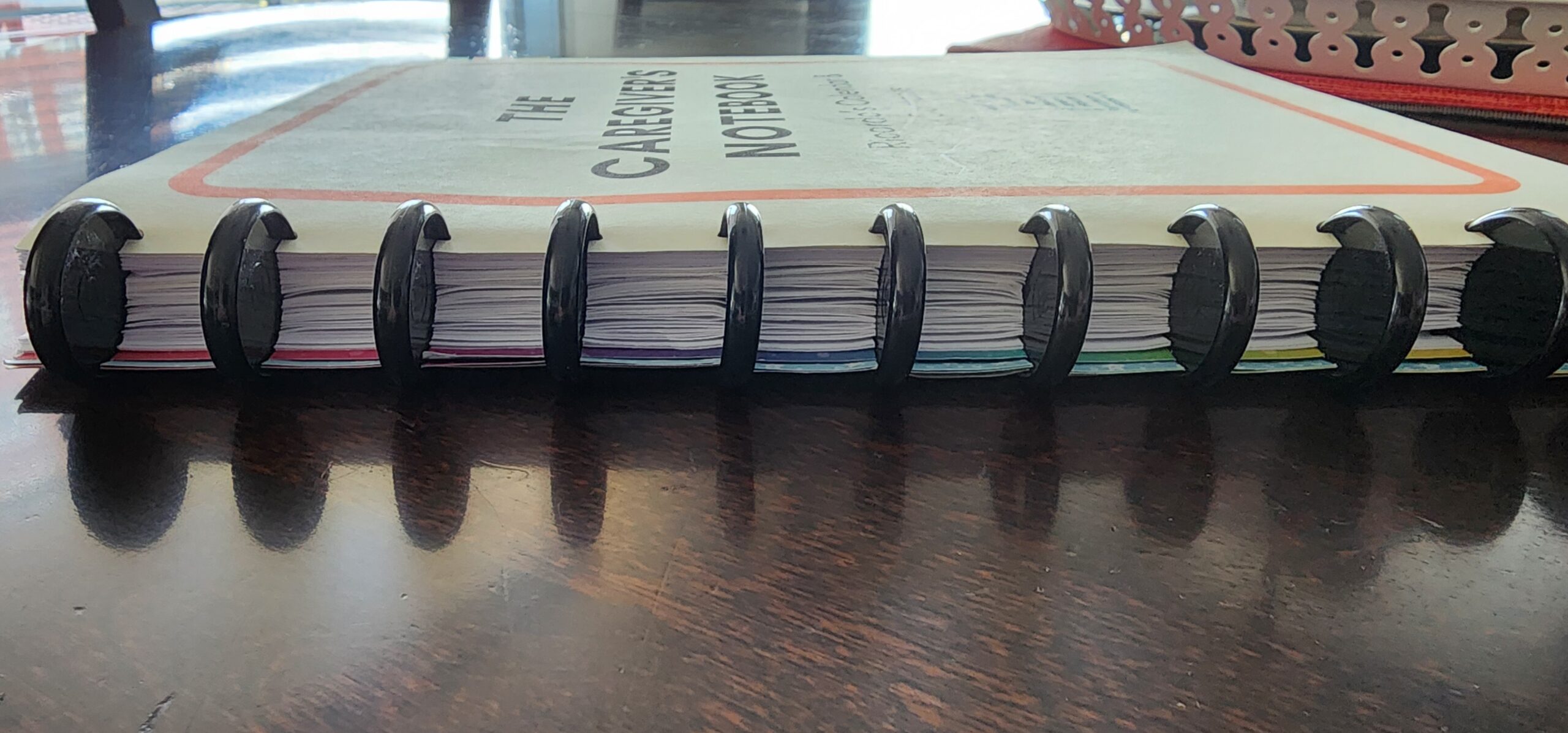
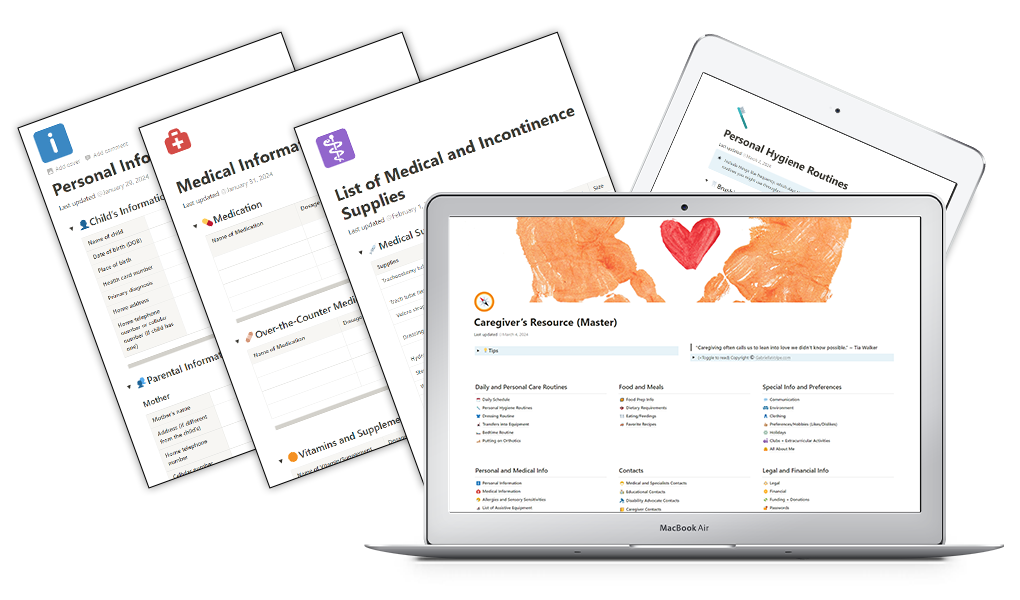
0 Comments